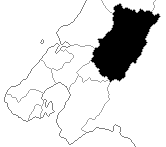Heretaunga (New Zealand electorate)

Heretaunga is a former New Zealand parliamentary electorate, in the city of Upper Hutt, that existed from 1954 until 1996.
Population centres
The First Labour Government was defeated in the 1949 election and the incoming National Government changed the Electoral Act, with the electoral quota once again based on total population as opposed to qualified electors, and the tolerance was increased to 7.5% of the electoral quota. There was no adjustments in the number of electorates between the South and North Islands, but the law changes resulted in boundary adjustments to almost every electorate through the 1952 electoral redistribution; only five electorates were unaltered.[1] Five electorates were reconstituted and the Heretaunga electorate was newly created, and a corresponding six electorates were abolished; all of these in the North Island.[2] These changes took effect with the 1954 election.[3]
The Heretaunga electorate was urban and was based on Heretaunga, a suburb of Upper Hutt in the northern Hutt Valley. Other places included Haywards and Birchville.[4]
History
The electorate originated in 1954, and lasted to 1996, when with the introduction of MMP it was replaced by Rimutaka.
In the 1951 election, Upper Hutt had belonged to the Otaki electorate, and the National Party's incumbent Member of Parliament, James Joseph Maher had defeated the Labour' Party's candidate, Phil Holloway. In the 1954 election, Upper Hutt belonged to the newly-formed Heretaunga electorate, and Holloway stood against National's Allan McCready and won decisively.[5]
Up to 1990 when Peter McCardle won the seat for National, the Labour Party held Heretaunga. In 1993, McCardle held the seat against a challenge from Labour candidate Heather Simpson (who went on to become Helen Clark's Chief of Staff, known as H2 – Clark was H1[6]). Subsequently, McCardle left the National Party (1996) and joined New Zealand First.
Members of Parliament
Key
| Election | Winner | |
|---|---|---|
| 1954 election | Phil Holloway | |
| 1957 election | ||
| 1960 election | Ron Bailey | |
| 1963 election | ||
| 1966 election | ||
| 1969 election | ||
| 1972 election | ||
| 1975 election | ||
| 1978 election | ||
| 1981 election | Bill Jeffries | |
| 1984 election | ||
| 1987 election | ||
| 1990 election | Peter McCardle | |
| 1993 election | ||
| (Electorate abolished in 1996; see Rimutaka) | ||
Election results
1954 election
| Party | Candidate | Votes | % | ± | |
|---|---|---|---|---|---|
| Labour | Phil Holloway | 8,911 | 63.78 | ||
| National | Allan McCready | 4,105 | 29.38 | ||
| Social Credit | Christopher Walter Tait | 955 | 6.84 | ||
| Majority | 4,806 | 34.40 | |||
| Informal votes | 128 | 0.91 | |||
| Turnout | 14,099 | 94.01 | |||
| Registered electors | 14,997 | ||||
Notes
- ↑ McRobie 1989, pp. 99f.
- ↑ McRobie 1989, pp. 95–100.
- ↑ McRobie 1989, p. 99.
- ↑ McRobie 1989, p. 98.
- 1 2 "Large Majority for Labour". Upper Hutt Leader. XI (48). 18 November 1954. p. 2. Retrieved 13 November 2014.
- ↑
Young, Audrey (29 January 2017). "Helen and Heather's great political partnership could be entering the twilight zone". The New Zealand Herald. Retrieved 9 September 2017.
Simpson then became director of policy and research for the parliamentary Labour Party before her elevation to chief of staff when she became Clark's 'enforcer' in the various political crises and scandals that arose as well as policy overseer. [...] She earned the nickname H2, as the second-most powerful woman in New Zealand, next to Helen Clark, H1.